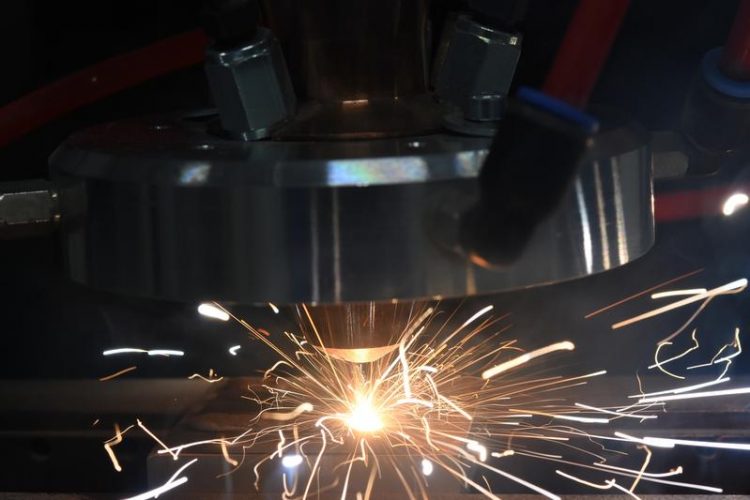3D Printing: New high-Tech Device for Bremen Material Scientists

High-tech at the University of Bremen: With laser metal deposition, metal parts and structures are produced by 3D printing. Anika Langebeck, Bias GmbH
Laser metal deposition (LMD) is an additive, powder-based production process for metals. This type of 3D printings allows for large construction parts and very delicate structures to be created at comparably high construction rates. With the help of LMD, structures can even be built on existing parts and surfaces.
The welding process can be used for production, coating, repairing, and modifying of 3D constructions. Amongst other applications, the process is used within the aerospace industry and increasingly in the automotive and engineering sectors. It is of great significance for Bremen’s industry.
New Materials, New Properties
The new LMD device offers material scientists entirely new possibilities for the researching of new metal materials: Several powder conveyors are employed at the same time in order to use varying metals in one working step and to quickly manufacture many differing samples.
It is in this way that completely new alloys with previously unattained properties are efficiently developed and manufactured or composite materials are printed.
The high-tech device, which is packed with the most innovative measuring technology, will deliver data that facilitates scientific understanding of the basic processes during powder mixing and conveying, the actual laser metal deposition, and in-situ heat treatment.
The Bremen scientists’ aim is the usage and evaluation of the new possibilities offered by this 3D printing technology for quick, expedient material development.
Top-Level Research in Bremen
“We deliver excellent top-level research in many areas – also in material research, as this success shows. The new, cutting-edge device will further material research in Bremen a great deal and will promote collaborations across the institution borders – which is in line with our cooperative university,” states the president of the University of Bremen, Bernd Scholz-Reiter, happily.
MAPEX spokesperson Professor Kurosch Rezwan also confirms this: “The research into new material and technologies in material processing is a significant stepping stone on the path to a more material and energy efficient future. Taking the quantity of processes and data that we now illustrate into consideration, interdisciplinary communication is becoming continually more important.”
Since 2014, the MAPEX Center for Materials and Processes has been a supporter of the collaboration between various university faculties and non-university research institutes. Alongside the planned core facility for material analysis, which will be built in the coming years, new research possibilities and cooperations within the MAPEX group will become possible thanks to the DFG funded high-tech LMD device at the University of Bremen. Researchers from various University of Bremen faculties, the Leibniz Institute for Material Engineering (IWT), and the BIAS – Bremen Institute for Applied Bean Technology, will use the device.
Scientific Communication Will Profit
“It will further strengthen the scientific communication and collaboration at this location and will promote Bremen in the important research field of additive production,” expects Professor Frank Vollersten, BIAS institute head. He has several years’ experience in the field of laser material processing and the group will build on his know-how in the area of LMD processes.
It is planned that the device be integrated in the joint fundamental research of the collaborative research center (CRC) 1232 “From colored states to evolutionary structural materials”. This CRC at the University of Bremen is developing a high throughput method for the discovery of entirely new and sustainable alloy concepts. “This large device is the ideal tool for flexible and particularly quick production of samples and will open new opportunities for CRC 1232,” enthuses Professor Lutz Mädler, CRC 1232 spokesperson and an IWT director.
Participating Scientists:
Seven MAPEX scientists from four different institutes were involved in the successful proposal submitted in the frame of the DFG Major Instrumentation Initiative “Laser Metal Deposition for High Throughput Analyses and Additive 3D Productions of Complex Alloys and Composite Materials” (Laser-Auftragschweißen für Hochdurchsatzuntersuchungen und additive 3D-Fertigungen komplexer Legierungen und Verbundwerkstoffe):
Prof. Dr.-Ing. Lucio Colombi Ciacchi, HMI, University of Bremen
Prof. Dr. phil. nat. Rolf Drechsler, Computer Architecture Group, University of Bremen
Dr.-Ing. Nils Ellendt, CRC 1232 “From colored states to evolutionary structural materials” managing director
Prof. Dr.-Ing. habil. Lutz Mädler, Mechanical Process Engineering, IWT
Prof. Dr.-Ing. Vasily Ploshikhin, ISEMP, University of Bremen
Dr.-Ing. Matthias Steinbacher, Materials Engineering/Metals, IWT
Prof. Dr.-Ing. Frank Vollertsen, Welding Technology and Related Processes, BIAS
Further Information:
https://www.uni-bremen.de/en/mapex/
www.iwt-bremen.de (in German only)
www.bias.de/en/
www.uni-bremen.de/en/
Contact:
Dr. Hanna Lührs, MAPEX Center for Materials and Processes
University of Bremen
Phone: +49 421 218-64580
Email: mapex@uni-bremen.de
Carolin Haller, IWT Leibniz Institute for Material Engineering
Phone: +49 421 218-51374
Email: haller@iwt-bremen.de
Christine Steffens, BIAS – Bremer Institut für angewandte Strahltechnik GmbH
Phone: +49 421 218-58130
Email: steffens@bias.de
Media Contact
All latest news from the category: Materials Sciences
Materials management deals with the research, development, manufacturing and processing of raw and industrial materials. Key aspects here are biological and medical issues, which play an increasingly important role in this field.
innovations-report offers in-depth articles related to the development and application of materials and the structure and properties of new materials.
Newest articles
Humans vs Machines—Who’s Better at Recognizing Speech?
Are humans or machines better at recognizing speech? A new study shows that in noisy conditions, current automatic speech recognition (ASR) systems achieve remarkable accuracy and sometimes even surpass human…

Not Lost in Translation: AI Increases Sign Language Recognition Accuracy
Additional data can help differentiate subtle gestures, hand positions, facial expressions The Complexity of Sign Languages Sign languages have been developed by nations around the world to fit the local…

Breaking the Ice: Glacier Melting Alters Arctic Fjord Ecosystems
The regions of the Arctic are particularly vulnerable to climate change. However, there is a lack of comprehensive scientific information about the environmental changes there. Researchers from the Helmholtz Center…



